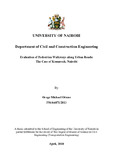| dc.description.abstract | Walkways facilitate movement of people, and in this thesis a sidewalk includes any type of
dedicated passage for pedestrian oriented activities. Even with pedestrians constituting a large
proportion of trip makers along Nairobi’s urban areas, the current practices of the local authorities
underestimate the importance of walking. The urban roads and streets in a high density, mixed-use
development area, have been designed taking into consideration the requirements of vehicular
growth and neglecting pedestrian’s needs. In cases where facilities are provided, they are either
encroached by hawkers or physically obstructed by parked vehicles. Consequently, pedestrians are
forced to use the road carriageway, hence increasing their frictions and making them vulnerable. In
order to determine how well pedestrian walkways accommodate pedestrian movement, or how safe
it is crossing the road, this study assesses the walking conditions in Nairobi’s Eastlands area. It
evaluates the level of service of the pedestrian walkways along urban roads in Komarock, based
primarily on space, speed, and density, and includes safety as a potential performance element. This
study revealed that the pedestrian walkway width in Komarock Area varies from between 0 meters
to 2 meters and as such cannot accommodate the high pedestrian densities during peak morning and
evening hours. This lead to the pedestrians competing with motorised transport for movement space
thereby causing conflict. The study recommends redesign of the pedestrian walkway along Kayole
Junction to the recommended 2.0m width, which can also accommodate disabled movement,
installation of raised pedestrian crossing humps along Kayole Junction, Masimba and Mama Lucy
Junction to reduce vehicular speeds, installation of raised kerbs and 1.0m high railings along the
entire study area to allow for the segregation of motorised and non-motorised transport and
demolition of structures occupying part of the walkway width and enforcement of laws regarding
encroachment, in order to keep the pedestrian walkways free from encumbrances. The findings of
this study are compared with the planning, design and operation guidelines for pedestrian facilities
and recommendations made in research studies from developed countries in an attempt to enhance
pedestrian environments in Kenya.
Key words: Pedestrian Flow Characteristics, Pedestrian Level of Service, Pedestrian Space,
Pedestrian Speed, Pedestrian Density, Pedestrian Walkways | en_US |

